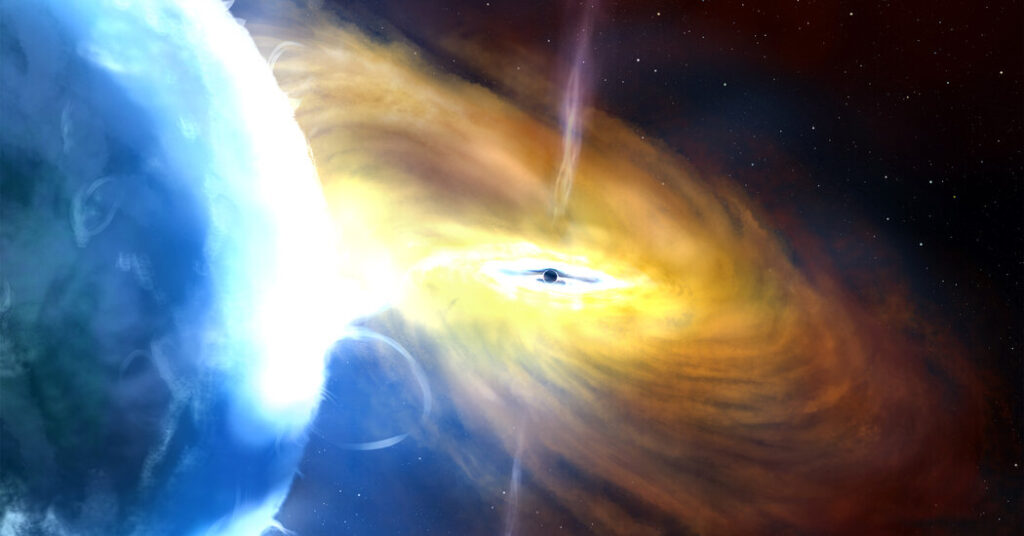It’s a dog-eat-dog cosmos. Not two weeks ago, on May 3, astronomers reported observing a star that was in the process of swallowing one of its own planets. Just two days earlier, another team had described black holes that were ripping stars apart and consuming them in a process known as tidal disruption event, or T.D.E.
Now an international group of astronomers reports that it is observing one of the most violent and energetic acts of cosmic cannibalism ever witnessed, perhaps the biggest explosion seen yet in the history of the universe. Eight billion light-years from Earth, in the darkness beyond the constellation Vulpecula, a black hole perhaps a billion times as massive as the sun seems to be gorging on a humongous cloud of gas. A study of the phenomenon appeared Friday in Monthly Notices of the Royal Astronomical Society.
The study began on April 13, 2021, when the Zwicky Transient Facility, a small telescope that was busy looking for exploding stars, or supernovas, spotted a bright flash that did not fit expectations. Most supernovas fade after a few weeks; this one, known as AT2021lwx, kept going — and has continued to explode for three years now.
In fact, the explosion turned out to have been first detected a year earlier by the Asteroid Terrestrial-impact Last Alert System, or ATLAS, a network of robotic telescopes in Hawaii, South Africa and Chile. That was the actual start of the cataclysm; as it proceeded, a worldwide network of telescopes and satellites has monitored it, measuring its emanations across the electromagnetic spectrum, from high-energy X-rays down to the infrared.
“Most supernovae and tidal disruption events only last for a couple of months before fading away,” said Philip Wiseman, an astrophysicist at the University of Southampton and the lead author of the new paper. “For something to be bright for two-plus years was immediately very unusual.”
What was going on? “At first we thought this flare-up could be the result of a black hole consuming a passing star,” said Matt Nicholl of Queen’s University Belfast, who helped analyze the ongoing explosion. “But our models showed that the black hole would have to have swallowed up to 15 times the mass of our sun to stay this bright for this long.”
Another idea t was that it was an outburst from a quasar — energy squirting from the edge of a supermassive black hole at the heart of a galaxy. But there was no record of previous quasar activity at the location, nor was there any visible sign of a galaxy there.
Of the many unlikely explanations, the most likely, Dr. Wiseman and his colleagues concluded, was that a black hole as massive as a billion suns was enjoying a prolonged feast on a gigantic cloud of gas. They have encouraged colleagues to be on the lookout for similar events.
“AT2021lwx is an extraordinary event that does not fit into any common class of transient,” Dr. Wiseman said in an email. He added that, with a total radiated energy equal to 100 supernovas, “it is one of the most luminous transients ever discovered.”
Jolt for jolt, that would put it in the company of colliding black holes. “Black holes colliding release energy in gravitational waves at an extreme luminosity — 10 billion times more ‘powerful’ than this explosion,” Dr. Wiseman wrote. “But that power only lasts for 20 milliseconds,” adding that this explosion has lasted years.


